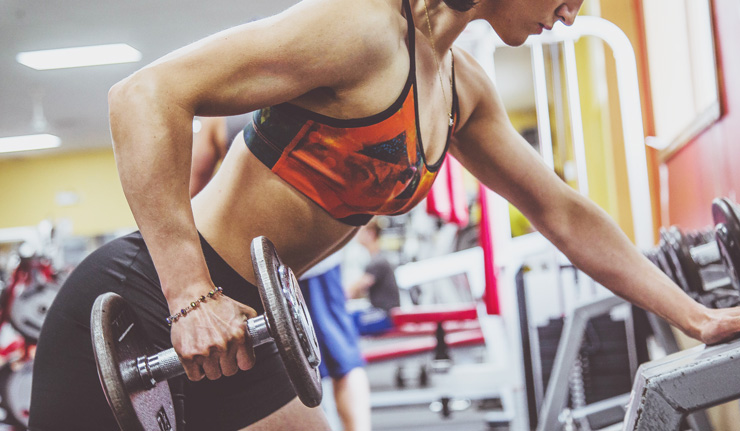
Weight lifting is a wonderful way to strengthen your body but it’s essential to do your resistance training properly to avoid injury and maximize results
—
Resistance training is a fantastic tool for reshaping your body and boosting your health. However, if not done right, it can be dangerous. It’s essential to start slowly and use proper technique.
Resistance training offers a wide range of health benefits. These range from reducing the risk of developing dangerous conditions, such as type 2 diabetes or cardiovascular disease, to reducing cholesterol levels and strengthening joints. However, these benefits come at a price: the risk of injury. This is especially true for new moms eager to get back in shape and reap the weight loss benefits of weight training.
Here are 5 tips to make resistance training safe and effective for beginners:
1. Get Your Rest
Rest is your best protection when working with weights. The most important safety rule for everyone who does resistance training is to avoid overloading individual muscle groups, so you need to take a full-day break once every three days. During this time you should not go near any weights, but you definitely should do some light exercise such as basic yoga or swimming. It might be best to remember your fitness roots and engage in play which can be transformed into exercise. Hear that, moms?
2. Start Simple (But Be Consistent)
Resistance training offers great results for weight loss, but it’s not a low-impact form of exercise. As such obese and severely overweight people are at particular risk of joint and skeletal damage. If you are already suffering from these complaints, you need to be extra careful with weight lifting. Again, baby weight-shedding moms need to be more careful here as pregnancy often results in various bone and joints problems. If you have any of those, talk to your doctor before you start lifting weights. Sadly, some exercises might be completely prohibited depending on your condition.
If you carry a lot of extra weight on you, it’s essential that you start with the most basic dumbbell workout and keep the resistance to a minimum. You might not even feel the impact of it the first few times you repeat the workout, but you’ll definitely start feeling the positive effects and seeing the positive changes within a few weeks.
Consistency is key to success in any type of weight loss program.
But this doesn’t mean that you have to invest in an expensive gym membership to stay in shape. To get a good workout anywhere, you should equip your home (and perhaps your office) with basic tools for resistance training. This “minimum strength fitness kit” should include dumbbells, resistance bands, weights, and a barbell.
3. Stretch After Lifting
To achieve the best results for your body, it is important to strengthen and lengthen your muscles. This means that you also need to get flexibility training alongside your resistance workouts.
It is vital to start and end every workout with some stretching and to practice yoga or some other flexibility-oriented techniques on your rest days. This way you will be able to reduce the risk of common resistance training injuries as well as cut down on the muscle ache that is unavoidable when you start exercising.
4. Mind Your Form
Maintaining perfect form is critical in resistance training — and not just because you look better when lifting weights the right way (although you do!). The important reason is that moving correctly minimizes the risk of injury and maximizes the potential benefits of each exercise.
Form is much more important than speed and intensity for resistance workouts. This means you should go slow at first and focus completely on the precise movement.
It’s also the reason why it is best to start your resistance exercise with a trainer. If that is not possible, watch several YouTube videos which analyze and explain every exercise, and then practice these slowly until you can perform them perfectly.
As a beginner you should do 8-12 reps — or even less, depending upon your level. There should be no rush in the beginning and later it will become easier as you develop muscle memory.
5. Do Your Cardio
Strength training should always go hand in hand with cardio, especially if your main goal for exercising is to lose weight. Professional bodybuilders usually have a few days of intense cardio workouts a week mixed with their weight lifting. Another common practice for pros is to add a 30-45-minute-long cardio session to a resistance workout.
However, as a complete beginner, you should not risk the extreme loads that such training requires. Instead, you should start your resistance workouts with about five minutes of aerobic warm up. A light jog or some lunges would work best for this.
The only exception is swimming, which is a perfect exercise for ‘rest days’. This low-impact cardio will tone all your muscles and make them hurt less after your intense resistance sessions, so practice swimming as often as you can to complement your strength-building strategy and improve your overall well-being. If possible, particularly if you suffer from joint aches, do some light aerobic exercises in the water.
New moms can get their basic cardio by playing with their baby and a ball. They can also join you during the stretching part of your workout. Doing so will help get your precious child into sports while they are young, while also helping you to stay strong and healthy!
You may also enjoy Best Self Yoga Flow for Flexibility and Relaxation by Carter Miles